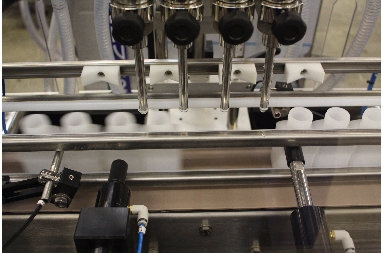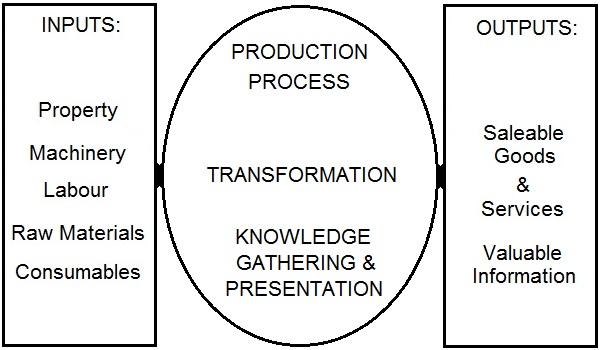|
The Production Process!
Production process and
The ultimate target of the production process is to make The main resources and stagesthat are involved to make up the production process are shown here below.
How well-organised a business is at performing this transformation process will ultimately determine its success level. This level is what's known as the productive efficiency of a firm and it needs to be as efficient as possible. Efficiency in transforming its input resources into saleable output products lowers production (transforming) costs. This means using the minimum amount of input resources as possible to achieve a set amount of product outputs. While utilising the minimum amount of transforming costs like labour, electricity, waste output Doing this will minimise the production cost per unit and give the firm the ability to sell at a lower competitve price. Thus gaining an advantage over other competitve firms suppying the same product or service. Ultimately, the objective of the production process is to create goods and services that meet the needs and wants of customers. The needs and wants of customers will be met if a business can produce the correct number of products, in the shortest possible time, to the best quality and all at a competitive price. This is the underlying mission of success behind any and every successful firm. Despite any other mission statement they may portray on thier "About Us" page. The process of production is concerned with transforming a set range of inputs, depending on the product, into those outputs that are required by the market (demand). In the process of production, a business or firm must first purchase all the necessary raw materials (inputs) for production. Then use the production process to transform them into the finished product (outputs) that it wishes to sell. This basically involves two main sets of resources - the resources to be transformed, and the resources that do the transforming. The resources to be transformed are in fact the raw materials and components that are transformed into end products. The resources that do the transforming include the buildings, machinery, computers, staff, and even the electricity that are needed to carry out the transforming processes. virtually any production process involves a set of links, in fact a series of links which form a production line or chain. At each stage of the chain value is added to the final product in the course of production. Each stage that's adding value to the product involves making the product more desirable as a finished unit to the consumer so that they will pay more than the raw cost for it. It's very important for all businesses that they identify the any parts of the process that add value, so that they can optimize these processes for the ultimate benefit of the business. Adding value to a product therefore is not just about the manufacturing process, but relates to all portions of the product making and sale processes e.g. advertising, promotion, distribution, etc, all of these add value to make the final product more desirable. Take for example a pump manufacturer. How well-organized and efficient a firm is at carrying out this transformation process will ultimately determine the manufacturing company's success. This is what's widely known as the productive efficiency of a firm and it will need to be as higher efficiency as possible in transforming its inputs into outputs. Profit = sale price (output) - costs(inputs). This will make sure the cost per unit of production is as low as can be and allow the manufacturing firm to sell at a lower price, ideally lower than the competitors. Computer-aided manufacturing is sometimes employed within the production process to get the best overall equipment effectiveness and operations efficiency to keep the cost per unit to a minimum. Ultimately, the objective of the production process is to create goods and services that meet the needs and wants of customers. The needs and wants of customers will be met if a business can produce the correct number of products, in the shortest possible time, to the best quality and all at a competitive price. There are three main types of production process is use: Job Production - Batch Production - Flow Production. Job Production Process:The Job or single product production process, is the creation of single items, (quite often large but not always) by either a single person/operative, or a team of people/operatives. For example building a car, creating a program system (like Windows). It is quite often happens that a number of identical job production processes to be running in parallel under job production, for example; several cars of a similar type. Smaller jobs/projects can also be seen in the light of a form of job production, items such as hand knitted clothing, writing a novel, or even the complete rewire of a house. Job production is a unique process in the fact that the job or project is considered to be a single operation, which requires the complete attention of the operative before he or she passes on to the next job. Other good examples of job production is the work carried out by the service industries including cutting hair, and processing a customers order in a stores like Index or Curry's. The benefits to be had by job production are: 1. The job is a unique product, which exactly matches the requirements of the customer, often from as early as the design stage. It will therefore tend to be specific to a customer's order and not in anticipation of a sale. This type of work is often referred to as commissioned work. For example, if a person wanted a customized spray paint job on a motorbike or car, they would first discuss with a customer what sort of design he or she would like to have. A detailed sample sketch would then be produced on paper or PC. Once the artwork has been approved by the customer the custom painter would set about applying the approved artwork to the car or motorbike in the design and fashion that has been agreed. The background work would be sprayed on with an airbrush first before the fine top detail is painted on. The finished artwork would then be inspected by the customer who will be happy to pay for a well produced unique product. 2. As the work is specific to the production unit itself, supervision and inspection of the work at various stages of completion is relatively simple and straightforward. 3. Some of the specifications or details involved in the job can change during the time taken by the manufacturing process, dependant upon the customer's inspection to meet his or her changing needs. For example, when a printing firm is asked to produce a catalogue for a grocery chain it is relatively simple to change the prices of some of the goods listed in the catalogue. 4. Working on a single unit job, coping with a variety of tasks and being part of a small team working towards the same aim would provide employees with a greater level of satisfaction. For example, aircrew's working for United Airways would treat each flight as a specific job, with passengers requiring individual attention to their specific needs - e.g. for vegetarian dishes, wheelchair access to the flight, etc.
Batch Production Process: For example, say on Monday, a machine produces say 100 of one type of part, on Tuesday the same machine reworks all the parts to complete a stage toward the finished product. Then on Wednesday the machine makes the same amount of different parts. And so on until all the parts required are made. Then all parts will then go forward to the final assembly. When all the parts are made and and the final product is assembled, there will be 100 finished products.
Batches are continually processed through each machine step before moving on to the next operation. This method is sometimes referred to as 'intermittent' or 'staged' production as different job types are held as work-in-progress between the various stages of production. The benefits of batch production are: 1. It is particularly suitable for a wide range of almost similar goods, which can use the same machinery on different settings. For example batches of letters can be sent out to customers of an insurance company. 2. It economizes upon the range of machinery needed and reduces the need for a flexible workforce. 3. Units can respond quickly to customer orders by moving buffer stocks of work-in-progress or partly completed products through the final production stages. 4. It makes possible economies of scale in techniques of production, bulk purchasing and areas of organization. 5. It makes costing easy and provides a better service for management information systems.
Flow Production Process: Units are worked upon in each operation and then passed straight on to the next work stage without waiting for the batch to be completed. To make sure that the production line can work smoothly each operation must be of standard lengths and there should be no movements or leakages from the line, i.e. hold-ups to work-in-progress.For flow production to be successful there needs to be a continuity of demand. If demand varied, this could lead to a constant overstocking of finished goods. Although with modern robotics it is possible to create variations in products being produced through continuous flow techniques, typically such products will be relatively standardized.Achieving a smooth flow of production requires considerable pre-production planning to make sure that raw materials are purchased and delivered just-in-time, that sufficient labour is employed and that there is continuous attention to quality throughout the production process. The benefits of flow production are: * ease of using just-in-time techniques to eliminate waste and minimize costs * labour and other production costs will be reduced through detailed planning and the use of robotics and automation * deviations in the line can be quickly spotted through ongoing quality control techniques * as there is no rest between operations, work-in-progress levels can be kept low * the need for storage space is minimal * the physical handling of items is minimal * investment in raw materials and parts are quickly converted into sales * control is easy. Go from Production Process back to Production page. Go onwards to Production Scheduling Software page. Go onwards to Small Order Manufacturing page. Return from Production Process to Home page.
|

